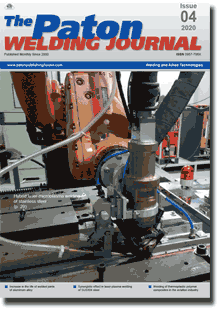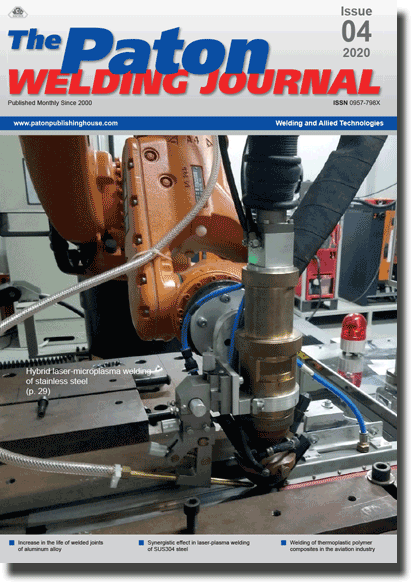| 2020 №04 (04) |
DOI of Article 10.37434/tpwj2020.04.05 |
2020 №04 (06) |

The Paton Welding Journal, 2020, #4, 30-35 pages
Welding of thermoplastic polymer composites in the aircraft industry (Review)
M.V. Iurzhenko1, M.V. Korab1, R.V. Kolisnyk1, O.P. Masiuchok1, A.S. Andreev2 and V.S. Petropolsky2
1E.O. Paton Electric Welding Institute of the NAS of Ukraine 11 Kazymyr Malevych Str., 03150, Kyiv, Ukraine. E-mail: office@paton.kiev.ua
2Antonov Company 1 Akademika Tupoleva Str., 03062, Kyiv, Ukraine, E-mail: support@antonov.com
Abstract
The volume of polymer composite structures in the aircraft industry is steadily increasing. Polymer composites based on thermosetting matrices are traditional in this field, but it is important to use new thermoplastic composites (TPCs), which have several advantages over thermosetting ones. The use of thermoplastic composite materials makes it possible to actively use welding processes in the production of structures, which significantly increases the productivity of work and reduces their cost. In the aircraft industry 3 types of heat-resistant polymers of the class of polyarylene are mostly used: polyetheretherketones (PEEK and PEKK), polyetherimide (PEI) and polyphenylene sulfide (PPS). Aeronautical structures are characterized by a large variety and complexity of forms, that’s why almost all known methods of plastic welding are involved for joining. The resistance welding of polymer materials applying embedded elements made of metal mesh or carbon fabric is actively used. Induction welding technology is suitable for joining structures made of conductive carbon composites. Ultrasonic welding, laser welding, and indirect-heated tool welding are also used in aircraft engineering. Nowadays, welding processes are usually digitally controlled with permanent data storage, but currently the agenda is to move to linear process control using temperature monitoring. This paper, based on the materials of European publications, presents examples of the application of different welding methods in the manufacture of structures made of modern polymer thermoplastic composites in the aircraft industry. 16 Ref., 9 Figures.
Keywords: polymer composites, thermoplastics, welded joints, resistance welding, induction welding, ultrasonic welding
Received 13.02.2020
References
1. Kiva, D. (2012) Aviation secor on science wings. Viche, 21. http:.//veche.kiev.ua/journal/3366/ [in Ukrainian]2. Belikov, S.B., Volchik, I.P., Mityaev, O.A., Pleskach, V.M., Savchenko, V.O. (2017) Composite materials in aircraft construction (Review). In: New materials and technologies in metallurgy and machine building. 1. http://nmt.zntu.edu. ua/article/view/131033/126779 [in Ukrainian].
3. Chris Red (2014) Thermoplastics in Aerospace Composites Outlook, 2014-2023. Composites World, 1. https://www.compositesworld.com/articles/the-outlook-forthermoplasticsin-aerospace-composites-2014-2023
4. W. D. Callister Jr., D. G. Rethwisch (2015) Fundamentals of Materials Science and Engineering: An Integrated Approach, Wiley; 5th Ed., 960.
5. https://www.tencatecomposites.com/resources/datasheets
6. https://www.porcher-ind.com
7. Da Costa A. P., Botelho E. C., Leali Costa M., Narita N. E., Tarpani J. R.. (2012) A Review of Welding Technologies for Thermoplastic Composites in Aerospace Applications. Journal of Aerospace Technology and Management, 4, 3, 255265. http://www.jatm.com.br/papers/vol4_n3/JATMv4n3_ p255-266_A_Review_of_Welding_Technologies_for_ Thermoplastic_Composites_in_Aerospace_Applications.pdf https://doi.org/10.5028/jatm.2012.040303912
8. Offringa A. (2016) Thermoplastic composites in aerospace. Breakthrough Technologies for Advanced Manufacture, Nottingham. http://www.sampe.org.uk/assets/documents/pdfs/ AS2016/Presentations/AS2016_01_Arnt_Offringa_Fokker.pdf
9. Gardiner G. (2018) Welding thermoplastic composites. Composites World, 9, p. 50 - 63. https://sc.edu/about/centers_institutes/ mcnair/documents/composites_world_september.pdf
10. Ahmed T.J., Stavrov D., Bersee H.E.N., Beukers A. (2006) Induction welding of thermoplastic composites-an overview. Composites Part A, t. 37, 10, 1638-1651. https:// www.deepdyve.com/lp/elsevier/induction-welding-ofthermoplasticcomposites-an-overview-ps031YzeOD https://doi.org/10.1016/j.compositesa.2005.10.009
11. Gardiner G. (2008) New horizons in welding thermoplastic composites https://www.compositesworld.com/blog/post/ new-horizons-in-welding-thermoplastic-composites
12. Palardy G., Villegas I. F. (2016) Smart Ultrasonic Welding of Thermoplastic Composites. Proceedings of the American Society for Composites - 31st Techn. Conf., ASC. https://pure.tudelft.nl/portal/files/12482685/1816.pdf
13. Aerospace 3D Printing Market Size, Share & Industry Analysis, By Vertical (Printers and Materials), By Industry Type (UAV, Aircraft, and Spacecraft), By Application Type (Engine Components, Space Components, and Structural Components), By Printer Technology Type (DMLS, FDM, CLIP, SLA, SLS and Others), and Regional Forecast 20192026. https://www.fortunebusinessinsights.com/industryreports/ aerospace-3d-printing-market-101613
14. Joshi, Sunil & Sheikh, Abdullah. (2015). 3D printing in aerospace and its long-term sustainability. Virtual and Physical Prototyping. 10. 1-11. 10.1080/17452759.2015.1111519. https://doi.org/10.1080/17452759.2015.1111519
15. 3D printing in aviation - advantages and areas of application https://www.mototok.com/blog/3d-printing-in-aviationadvantages
16. TOP 10 3D Printing in Aeronautics https://www.3dnatives. com/en/3d-printing-aeronautics-010320184/
Suggested Citation
M.V. Iurzhenko, M.V. Korab, R.V. Kolisnyk, O.P. Masiuchok, A.S. Andreev and V.S. Petropolsky (2020) Welding of thermoplastic polymer composites in the aircraft industry (Review). The Paton Welding J., 04, 30-35.The cost of subscription/purchase order journals or individual articles
| Journal/Currency | Annual Set | 1 issue printed |
1 issue |
one article |
| TPWJ/USD | 384 $ | 32 $ | 26 $ | 13 $ |
| TPWJ/EUR | 348 € | 29 € | 24 € | 12 € |
| TPWJ/UAH | 7200 UAH | 600 UAH | 600 UAH | 280 UAH |
| AS/UAH | 1800 UAH | 300 UAH | 300 UAH | 150 UAH |
| AS/USD | 192 $ | 32 $ | 26 $ | 13 $ |
| AS/EUR | 180 € | 30 € | 25 € | 12 € |
| SEM/UAH | 1200 UAH | 300 UAH | 300 UAH | 150 UAH |
| SEM/USD | 128 $ | 32 $ | 26 $ | 13 $ |
| SEM/EUR | 120 € | 30 € | 25 € | 12 € |
| TDNK/UAH | 1200 UAH | 300 UAH | 300 UAH | 150 UAH |
| TDNK/USD | 128 $ | 32 $ | 26 $ | 13 $ |
| TDNK/EUR | 120 € | 30 € | 25 € | 15 € |
AS = «Automatic Welding» - 6 issues per year;
TPWJ = «PATON WELDING JOURNAL» - 12 issues per year;
SEM = «Electrometallurgy Today» - 4 issues per year;
TDNK = «Technical Diagnostics and Non-Destructive Testing» - 4 issues per year.


